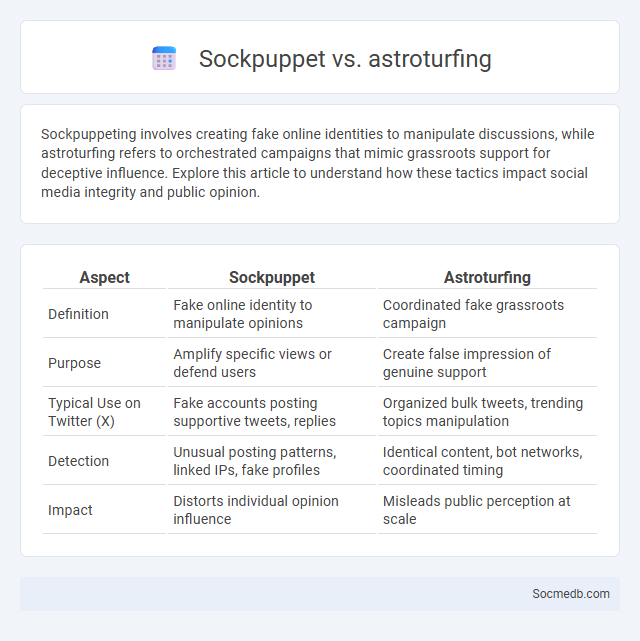
Photo illustration: Sockpuppet vs Astroturfing
Sockpuppeting involves creating fake online identities to manipulate discussions, while astroturfing refers to orchestrated campaigns that mimic grassroots support for deceptive influence. Explore this article to understand how these tactics impact social media integrity and public opinion.
Table of Comparison
| Aspect | Sockpuppet | Astroturfing |
|---|---|---|
| Definition | Fake online identity to manipulate opinions | Coordinated fake grassroots campaign |
| Purpose | Amplify specific views or defend users | Create false impression of genuine support |
| Typical Use on Twitter (X) | Fake accounts posting supportive tweets, replies | Organized bulk tweets, trending topics manipulation |
| Detection | Unusual posting patterns, linked IPs, fake profiles | Identical content, bot networks, coordinated timing |
| Impact | Distorts individual opinion influence | Misleads public perception at scale |
Understanding Sockpuppet: Definition and Examples
A sockpuppet is a false online identity created by an individual to deceive others and manipulate social media conversations. Common examples include users posting fake reviews or supporting their own opinions under multiple accounts to boost credibility or sway public opinion. Recognizing sockpuppet accounts involves analyzing behavior patterns, such as repetitive posting from IP addresses or identical language styles across profiles.
What is Astroturfing? Key Characteristics
Astroturfing is a deceptive social media practice where fake grassroots campaigns are created to manipulate public opinion by simulating authentic user support. This tactic involves using fake accounts or paid influencers to spread misleading information or endorsements, often disguising corporate or political agendas. Understanding these key characteristics helps you identify and resist inauthentic content designed to distort genuine social discourse.
Sockpuppet vs. Astroturfing: Core Differences
Sockpuppets involve individuals creating multiple fake accounts to manipulate online discussions, while astroturfing refers to orchestrated campaigns designed to appear as spontaneous grassroots movements. Your awareness of these tactics is crucial for identifying deceptive practices on social media platforms and maintaining authentic engagement. Recognizing the core differences helps in distinguishing between personal manipulation efforts and organized, strategic misinformation.
How Sockpuppets Operate Online
Sockpuppets operate online by creating multiple fake identities to manipulate social media conversations and influence public opinion. These accounts often post fabricated comments, like or share content to amplify certain messages, and disguise coordination efforts to avoid detection. Protecting your online space requires vigilance against these deceptive tactics to maintain authentic social interactions.
Techniques and Strategies in Astroturfing
Astroturfing techniques involve creating fake grassroots campaigns by orchestrating coordinated posts, fake accounts, and automated bots to simulate genuine public support on social media. Strategies include carefully crafting persuasive messages, timing posts to maximize visibility, and targeting specific demographics or communities to influence opinions subtly. Understanding these methods can help you identify and counteract deceptive social media manipulation effectively.
Motives Behind Using Sockpuppets and Astroturfing
Sockpuppets and astroturfing are often employed on social media to manipulate public opinion by creating fake endorsements or disguising biased campaigns as grassroots movements. These tactics aim to influence discussions, boost perceived popularity, or undermine genuine user feedback to sway target audiences. Understanding these motives helps you recognize inauthentic behavior and maintain a more trustworthy online environment.
Identifying Sockpuppets: Warning Signs
Sockpuppets on social media often exhibit repetitive posting patterns, such as consistently promoting the same viewpoints across multiple accounts with similar language or timing. Warning signs include newly created profiles with minimal personal information, rapid follower growth without genuine interaction, and coordinated commenting or liking behavior that appears automated or scripted. Detecting these indicators helps maintain authentic engagement and prevent manipulation in online communities.
Detecting Astroturfing Campaigns
Detecting astroturfing campaigns on social media requires analyzing patterns of coordinated posting, fake accounts, and suspicious engagement metrics that mimic genuine grassroots movements. Advanced algorithms and AI tools can help identify anomalies in behavior, such as repetitive messaging or bot-like interactions, ensuring you recognize inauthentic content quickly. Protecting your social media environment by scrutinizing sources and verifying user legitimacy strengthens your stance against deceptive influence operations.
Real-World Impact: Sockpuppets vs. Astroturfing
Sockpuppets involve individuals creating fake online identities to manipulate public opinion, while astroturfing is a coordinated campaign designed to appear as spontaneous grassroots support. Your ability to discern these deceptive tactics is crucial in navigating social media's complex landscape and fostering genuine community engagement. Recognizing the real-world impact of these practices is essential for maintaining trust and transparency on digital platforms.
Prevention and Ethical Considerations in Digital Communities
Promoting mental health and preventing cyberbullying are critical in creating safe social media environments. Implementing content moderation algorithms and encouraging digital empathy foster respectful interactions within online communities. Ethical considerations demand transparency in data handling and protection of user privacy to build trust and accountability.
 socmedb.com
socmedb.com